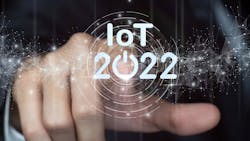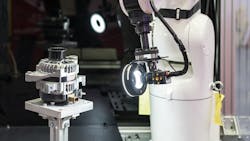Industrial and Commercial Markets Ripe for IoT Growth in 2022
This article is part of the 2022 Electronic Design Forecast issue
What you’ll learn:
- Why the IoT is ready for market expansion.
- How the commercial, industrial, and medical markets will adopt IoT solutions.
The Internet of Things (IoT) is ready for exponential growth this year, boasting robust technology and a thriving ecosystem. While the IoT is already thoroughly established in smart homes and quickly expanding to smart cities, the use of innovative IoT applications in the commercial, industrial, and medical spaces will drive early adopting companies forward.
From retail to healthcare and energy to manufacturing, the upcoming year will bring more advanced IoT solutions, improving sustainability, productivity, and safety of operations.
Post-Pandemic Retail Gets Smarter
Retailers have rapidly evolved in response to the pandemic, with the widespread adoption of IoT solutions like electronic shelf labels (ESLs) and asset-tracking systems. ESLs provide retailers with a centralized price-management solution without requiring labor-intensive manual price updates, thus freeing valuable staff to work on tasks that enhance the in-store shopping experience.
Asset tracking is another IoT solution that helps with the management of a store’s supply chain by helping retailers keep track of inventory. With IoT-powered asset tracking, managers can easily determine the quantity of items within stores and/or warehouses—an incredibly valuable ability due to the current constraints within the global supply chain.
Such data can provide critical insight to better meet the needs of customers and increase the efficiency of inventory management. In addition, asset tracking allows customer behaviors to be better understood, staffing to be optimized, and further improve the in-store shopping experience in 2022 for customers and workers alike.
IoT Expands from Commercial to Industrial Sector
The same asset-tracking systems being applied in the commercial space could be seamlessly adopted by the industrial market to drastically improve operations.
Tags, such as the Trackunit Kin product, can be placed directly on pieces of equipment at a warehouse, manufacturing facility, or construction site. These wireless tags allow for standardized workflow management by tracking the item’s location, usage time, fuel consumption, and maintenance timing. They also can protect against theft and help ensure the appropriate usage of the equipment.
Usage of these tags and other IoT tools signals a massive shift toward widespread technological adoption in the industrial market. Many companies have been hesitant to adopt wireless technology, opting instead for wired products that were previously seen as more secure and mature.
Wireless technology is no longer a new technology—it, too, has matured, having been deployed for more than 20 years while simultaneously becoming more secure. Companies that adopt wireless technology will reduce downtime and increase productivity, positioning themselves for long-term success and transforming the efficiency of their operations in the new year.
IT and OT Will Continue to Merge
As the industrial sector begins to embrace the solutions provided by the IoT in 2022, it’s important for engineers to focus on integrating their operational-technology (OT) systems, which automates heavy machinery using wired technology, into information-technology (IT) systems.
Many industrial companies are in the midst of advancing their IT systems, such as enterprise resource planning (ERP) and customer relationship manager (CRM) platforms, and OT is the next logical step to improving their overall operations and efficiencies. In the coming months, we will see more industrial companies merge their IT systems with new OT systems propelled by wireless technology. This significant shift in technology will lead to great advances for industrial companies that are able to successfully integrate the two systems.
To get to that point, engineers will be required to become more educated on IT-specific technology. This will help to create a synergy of IT and OT technology—until machinery is ultimately developed to fully integrate wireless technology.
Machine Learning Pushes All the Way to the Edge
In all industries, advances in machine learning (ML) are opening the doors to an exciting new future. Many benefits are able to be extracted from ML on the edge; an ML algorithm can train a model, evaluate its own performance, and make predictions. In 2022, we can expect to see ML applications expand to miniature devices that are used for life-easing applications, from predictive building maintenance and automation to vision and motion detection for autonomous operations.
As more industries adopt IoT devices, they will begin to experience the benefits of ML. For example, construction foremen can optimize the use of costly equipment to prevent maintenance issues caused by overuse as well as have a better idea of when maintenance will be required.
IoT Becomes a Platform and Not Just a Device
Another emerging trend we will see more of this year: The product distribution process for IoT devices will continue to become streamlined and companies will be able to deploy products at a large scale, rapidly growing their user base. Device makers and developers understand that long product lifecycles and great services are the keys to winning and maintaining customers.
Developers are now moving away from the sale of isolated products to an integrated product and service offering, which delivers continuous value while a product is in use. With the introduction of edge-to-cloud computing, IoT devices can continuously feed information about usage and condition back to the manufacturers, who then utilize this data to deliver proactive maintenance and better product features. Post-deployment insights can be used to learn about the user and iterate product itself.
Device makers continue to adopt new ways to update products remotely and safely in the field with the latest software and firmware. Over-the-air programming allows manufacturers to push new software features and additional functionality out to an entire fleet of installed smart devices at once, but this calls for more advanced security services.
With more IoT products being deployed in homes and mission-critical industries than ever before, developers will be responsible for preventing ever-evolving cyberthreats. Trusted security hardware and software solutions are essential to their success.
Information security teams will need to manage the devices throughout their entire lifecycle. It’s crucial to have advanced security and guarantee that the end-users’ private data will be handled with integrity at all times, utilizing roots of trust, secure code, and secure boot.
Security Enhancements to the IoT Open New Markets
As the security of IoT devices strengthens, we can expect IoT to become even more widely adopted. The medical space presents many use cases for the IoT, but adoption has been slow due to regulatory hurdles.
In the not-so-distant future, a patient’s standard hospital identification wristband also could include an asset-tracking device. The asset-tracking component could help better monitor all aspects of care, from medication administered and doctor consults, to bed and room locations. This application will give hospital administrators an important tool to streamline workflow, especially as they struggle with staff shortages—and give patients an enhanced standard of care.
Having the ability to track patients, assets (e.g., wheelchairs and medications), and even staff can provide hospital management with invaluable tools and data to better optimize day-to-day operations.
Strong Outlook
The upcoming year will mark an inflection point for silicon providers. The technology is robust, and the market is ripe. Even during a global chip shortage, the IoT market holds tremendous opportunity for the semiconductor industry. By 2023, global microcontroller shipments are expected to reach 30 billion units and show no signs of slowing down.
In the near future, there won’t be a single industry untouched by the virtues of IoT, edge, and network technology. Providing security remains a top priority for all.
Read more articles in the 2022 Electronic Design Forecast issue
About the Author
Ross Sabolcik
Senior Vice President and General Manager for Industrial and Commercial IoT Products, Silicon Labs
Ross Sabolcik leads Silicon Labs’ Industrial and Commercial IoT business unit. He oversees the delivery of connected, wireless solutions for industrial and commercial sectors including metering, industrial and building automation, commercial lighting, and connected retail applications.
Ross joined Silicon Labs in 1999 and holds a Master’s degree in computer and systems engineering from Rensselaer Polytechnic Institute and a Bachelor’s degree in electrical engineering from Penn State University. He currently serves on the executive committee for Austin Habitat for Humanity.




